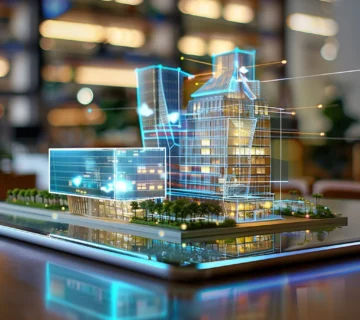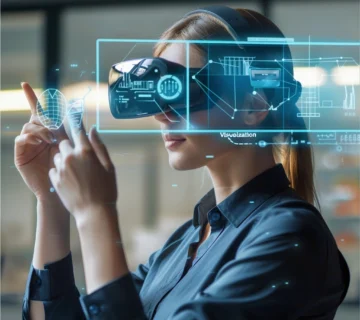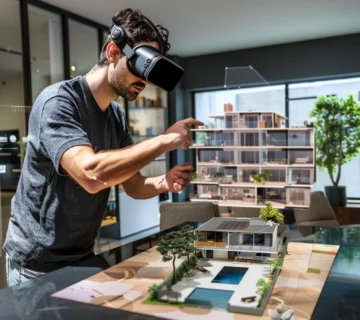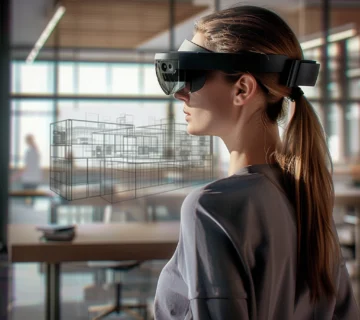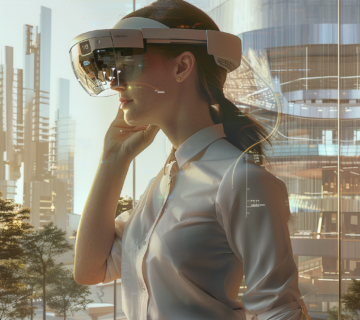Exploring the Boundless Realm of Augmented Reality (AR): 5 steps in Revolutionizing Industries by AR technology
In recent years, Augmented Reality (AR) has emerged as a beacon of innovation, captivating the imagination of technologists, entrepreneurs, and consumers alike. Its ability to seamlessly blend the virtual with the real has sparked a paradigm shift in how we perceive and interact with the world around us. As we stand on the cusp of a new era defined by digital augmentation, AR technology stands out as a transformative force with the potential to revolutionize industries across the board.
In this dynamic landscape of technological evolution, AR represents more than just a novel gadget or fleeting trend; it embodies a fundamental shift in our relationship with technology and the physical world. By augmenting our senses, enhancing our capabilities, and redefining our experiences, AR can reshape industries, disrupt traditional business models, and unlock new realms of possibility.
In this exploration, we embark on a journey to unravel the mysteries of Augmented Reality AR and uncover the five essential steps through which it is reshaping industries and redefining experiences. From understanding the foundational principles of AR technology to exploring its diverse applications across sectors such as architecture, education, healthcare, retail, and entertainment, we delve deep into the transformative potential of AR and its profound impact on the way we work, learn, shop, play, and connect.
Join us as we navigate through the boundless realm of Augmented Reality AR, charting a course toward a future where digital augmentation enriches every facet of our lives. In this journey of exploration and discovery, we invite you to embrace the transformative power of AR and witness firsthand the dawn of a new era in human-computer interaction. Welcome to the world of Augmented Reality AR, where the boundaries between the physical and digital dissolve, and the possibilities are limited only by our imagination to use AR visualization tools.
1. Understanding Augmented Reality (AR)
Augmented Reality Definition: Augmented Reality (AR) stands as a groundbreaking technology that seamlessly integrates digital information with the physical world, enriching perception and interaction in real time. Unlike its counterpart, virtual reality (VR), which immerses users in entirely computer-generated environments, AR overlays digital content onto the user’s view of the physical environment, enhancing their understanding and interaction with the world around them.
Evolution of AR Technology: The evolutionary trajectory of AR technology can be traced back to its conceptualization, where pioneers envisioned a future where digital information could augment human perception and interaction. Over time, through relentless experimentation and innovation, AR technology has evolved from rudimentary prototypes to sophisticated platforms, driven by advancements in hardware, software, and user experience design. From the early experiments with head-mounted displays to the development of mobile AR applications, the journey of AR has been characterized by a relentless pursuit of seamless integration and enhanced user experiences.
Augmented Reality vs. Virtual Reality: While AR and virtual reality (VR) share a common goal of enriching user experiences through digital augmentation, they fundamentally differ in their approach. Virtual reality creates immersive, simulated environments that completely replace the user’s view of the real world, transporting them to computer-generated realms. In contrast, AR enhances the user’s perception of the real-world environment by overlaying digital content, such as images, videos, or 3D models, onto their view of the physical world. This distinction between AR and VR lies at the heart of their respective applications and use cases, with AR offering a unique blend of virtual and physical elements to enhance everyday experiences.
2. AR Technology Unveiled
Exploring the Core Components of AR Systems: AR systems comprise essential components such as sensors, cameras, processors, and displays. These components work in tandem to perceive the physical environment, process data, and render digital content in real time.
The Role of Sensors and Cameras in AR Environments: Sensors, including gyroscopes, accelerometers, and GPS, gather data about the user’s surroundings, enabling precise spatial mapping and tracking. Cameras capture images and videos of the real-world environment, facilitating object recognition and spatial understanding.
Processing Power: The Engine Behind Seamless AR Experiences: AR applications rely on powerful processors and algorithms to process vast amounts of data in real time. From image recognition to spatial mapping, advanced processing capabilities are essential for delivering seamless and responsive AR experiences.
3. Augmented Reality Design: Crafting Immersive Experiences
Principles of AR Design: Effective Augmented Reality
design prioritizes seamlessness, contextuality, and user-centricity. By integrating digital content seamlessly into the real-world environment and considering contextual factors such as user location and the task at hand, designers can create immersive and intuitive experiences.
User Interface (UI) and User Experience (UX) in AR Applications: AR UI/UX design focuses on optimizing interactions between users and digital content in the augmented environment. Intuitive gestures, clear visual cues, and responsive feedback mechanisms are essential for enhancing user engagement and satisfaction.
Designing for Engagement: Interactive Elements in AR Design: Interactive elements such as virtual buttons, 3D models, and gamified experiences enrich AR applications, fostering user engagement and exploration. By leveraging interactive design principles, designers can create compelling and memorable AR experiences.
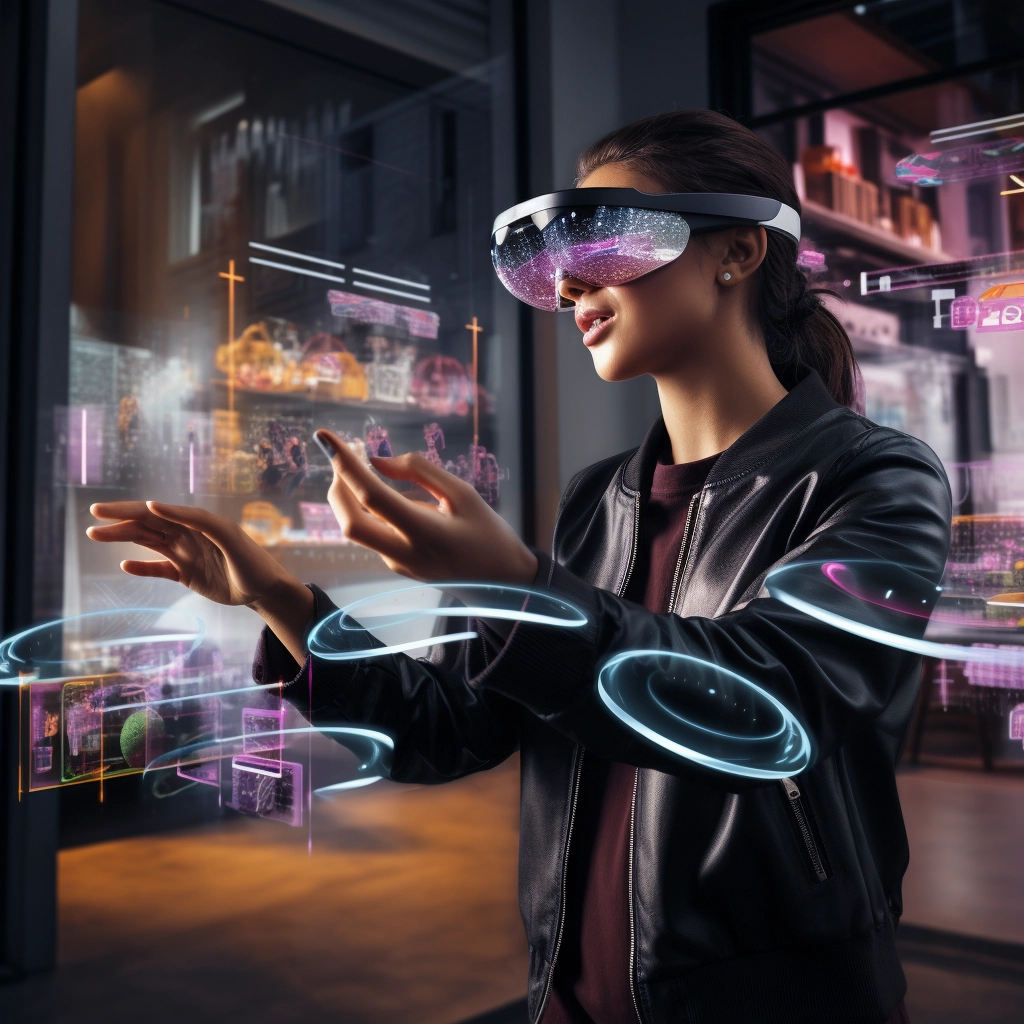
4. Augmented Reality (AR) in Architecture: Revolutionizing Design and Visualization
Redefining Architectural Visualization with Augmented Reality (AR): Augmented Reality (AR) technology is revolutionizing the field of architecture by enabling architects and designers to visualize and interact with digital models in real-world contexts. From concept design to construction planning, AR facilitates immersive and collaborative design processes.
Augmented Reality (AR)-Assisted Design: Enhancing Creativity and Collaboration: Augmented Reality (AR) tools empower architects to explore design ideas, iterate on concepts, and communicate with stakeholders more effectively. By overlaying digital models onto physical spaces, Augmented Reality (AR) bridges the gap between imagination and reality, fostering creativity and innovation.
Augmented Reality (AR) for Urban Planning: Transforming Cities into Interactive Spaces: In urban planning, AR offers innovative solutions for visualizing proposed developments, assessing environmental impacts, and engaging communities. By visualizing future scenarios in situ, Augmented Reality (AR) helps stakeholders make informed decisions and shape more livable and sustainable cities.


5. Applications of Augmented Reality (AR)
Applications of Augmented Reality (AR)
Augmented Reality (AR) has transcended its initial novelty and has found practical applications across various industries, revolutionizing the way we learn, receive healthcare, shop, and entertain ourselves. Let’s explore how the augmented reality definition is transforming these sectors:
1. Augmented Reality (AR) in Education: Transforming Learning Environments
Augmented Reality technology has opened up new horizons in education by making learning more interactive, engaging, and accessible.
AR enriches educational experiences by:
- Bringing abstract concepts to life: Augmented Reality (AR) enables students to visualize complex concepts in subjects like history, science, and mathematics by overlaying digital content onto real-world objects. For instance, students can explore ancient ruins in AR, dissect virtual organisms, or interact with 3D models of geometric shapes.
- Providing interactive learning opportunities: AR facilitates hands-on learning experiences, allowing students to engage with educational content actively. Whether it’s conducting virtual experiments in a chemistry lab, exploring historical landmarks in augmented reality tours, or solving interactive puzzles, AR immerses students in their learning journey.
- Enhancing student engagement, comprehension, and retention: By making learning more interactive and experiential, AR captivates students’ attention and fosters deeper understanding and retention of educational material. Studies have shown that AR-enhanced lessons lead to increased engagement, improved comprehension, and better long-term memory retention compared to traditional teaching methods.
This video explores Augmented Reality in 2030 and its top 5 future technologies”Future Business Tech”
2. Augmented reality design in Healthcare: Innovations in Diagnosis and Treatment
In the healthcare industry, Augmented Reality is revolutionizing medical training, patient care, and surgical procedures, ushering in a new era of precision, efficiency, and safety.
AR innovations in healthcare include:
- Medical training and education: AR simulators and applications allow medical students and professionals to practice surgical procedures, anatomical dissections, and diagnostic imaging in a realistic, risk-free environment. AR enhances hands-on learning and skill development by overlaying patient data, anatomical models, and procedural guidance in the real-world environment.
- Surgical navigation and assistance: During surgical procedures, AR technology provides surgeons with real-time guidance and visualization tools, improving accuracy, precision, and efficiency. By overlaying 3D reconstructions of patient anatomy onto the surgeon’s field of view, AR assists in surgical planning, intraoperative navigation, and tissue visualization, reducing the risk of errors and complications.
- Patient care and rehabilitation: AR applications empower patients to actively participate in their treatment and rehabilitation process by providing personalized instructions, exercises, and feedback in real time. Whether it’s guiding patients through physical therapy exercises, helping them manage chronic conditions, or assisting in remote consultations, AR enhances patient engagement, compliance, and outcomes.
3. AR in Retail: Personalized Shopping Experiences
In the retail industry, Augmented Reality offers personalized shopping experiences, transforming the way customers explore, interact with, and purchase products.
AR enhances retail experiences by:
- Visualizing products in real-world environments: AR applications allow customers to visualize how products will look and fit in their own homes or surroundings before making purchase decisions. Whether it’s trying on virtual clothes, previewing furniture in a room, or testing out cosmetics on their skin, AR enables shoppers to make more informed choices and reduces the likelihood of returns.
- Providing interactive product demonstrations: AR experiences engage customers through interactive product demonstrations, virtual try-ons, and immersive storytelling. Whether it’s showcasing the features of a new gadget, demonstrating the functionality of a piece of equipment, or presenting the benefits of a skincare product, AR enhances customer engagement and understanding.
- Personalizing the shopping journey: AR-powered recommendation engines and virtual assistants provide personalized product recommendations, styling tips, and shopping assistance based on individual preferences, behavior, and context. By tailoring the shopping experience to each customer’s needs and preferences, AR enhances customer satisfaction and loyalty.
4. Augmented Reality in Entertainment: Immersive Storytelling and Gaming
Augmented Reality (AR) is revolutionizing the entertainment industry by offering immersive storytelling experiences and interactive gaming adventures that blur the boundaries between the real and virtual worlds. Here’s a closer look at how AR is reshaping entertainment:
Immersive Storytelling Experiences:
AR enables storytellers to create immersive narratives that seamlessly blend digital content with the real-world environment. These immersive storytelling experiences transport audiences into captivating worlds where imagination comes to life. Whether experienced through mobile devices, smart glasses, or location-based installations, Augmented Reality (AR) storytelling offers unprecedented levels of engagement, interactivity, and immersion.
- Interactive Museum Exhibits: Augmented Reality (AR) transforms traditional museum exhibits into interactive experiences where artifacts and historical figures come to life. By overlaying digital reconstructions, animations, and audio guides onto physical exhibits, AR enhances the educational value and emotional impact of museum visits, making history and culture more accessible and engaging to audiences of all ages.
- Location-Based Storytelling Experiences: AR storytelling experiences take audiences on guided tours of cities, landmarks, and historical sites, where they uncover hidden stories, solve mysteries, and interact with virtual characters and objects. By combining GPS tracking, AR, and narrative storytelling, these location-based experiences blur the lines between fiction and reality, offering immersive adventures that unfold in real-world settings.
- AR Art Installations: AR artists push the boundaries of creativity by transforming physical spaces into interactive canvases where art comes to life. Whether displayed in galleries, public spaces, or digital platforms, AR art installations engage audiences through dynamic animations, soundscapes, and interactive elements, inviting them to explore, interact, and co-create immersive experiences.
Interactive Gaming Adventures:
AR gaming experiences combine real-world locations and digital gameplay elements, encouraging players to explore their surroundings, solve puzzles, and interact with virtual characters and objects. These interactive gaming adventures leverage the unique capabilities of Augmented Reality (AR) technology to deliver immersive and engaging experiences that captivate players of all ages.
- Location-Based AR Games: Location-based Augmented Reality (AR) games use GPS tracking and Augmented Reality (AR) to create virtual worlds that overlay the player’s view of the real world. Players embark on quests, capture virtual creatures, and compete against others in real time, turning streets, parks, and landmarks into playgrounds for digital adventures. Games like Pokémon GO and Harry Potter: Wizards Unite have captivated millions of players worldwide, demonstrating the immense popularity and potential of location-based AR gaming.
- AR Board Games: AR board games combine physical game pieces with digital enhancements to create dynamic and interactive gaming experiences. Players interact with virtual elements, solve puzzles, and strategize their moves using AR overlays displayed on smartphones, tablets, or AR glasses. These hybrid gaming experiences bridge the gap between traditional board games and digital entertainment, offering new possibilities for social interaction and gameplay innovation.
- Interactive AR Experiences: Beyond traditional gaming formats, Augmented Reality (AR) offers a platform for innovative and experimental gaming experiences that push the boundaries of creativity and technology. From immersive storytelling adventures to collaborative multiplayer experiences, Augmented Reality (AR) games engage players in new ways, fostering creativity, exploration, and social interaction in virtual worlds that coexist with the real.
In summary, Augmented Reality (AR) is reshaping entertainment by offering immersive storytelling experiences and interactive gaming adventures that transport audiences into captivating worlds of imagination and wonder. Whether experienced through museum exhibits, location-based tours, or interactive games, AR entertainment experiences blur the lines between reality and fiction, inviting audiences to explore, interact, and immerse themselves in new realms of storytelling and play.
Augmented Reality vs. Virtual Reality: Bridging Realities
While both Augmented Reality (AR) and Virtual Reality (VR) offer immersive digital experiences, they differ significantly in their approach and applications.
Augmented Reality (AR) enhances the real-world environment by overlaying digital content, such as images, videos, or 3D models, onto the user’s view of the physical world. This blending of virtual and physical elements enriches everyday experiences and offers practical applications across various industries, from education to healthcare to retail.
On the other hand, Virtual Reality creates entirely simulated environments that replace the user’s view of the real world, transporting them to computer-generated realms. By immersing users in virtual environments, VR offers unparalleled opportunities for gaming, simulation, and virtual exploration.
While both Augmented Reality (AR) and VR share the common goal of enhancing user experiences through digital augmentation, they cater to different use cases and audiences. Augmented Reality (AR) complements real-world interactions and environments, offering practical solutions for education, training, and everyday tasks. In contrast, VR provides immersive escapism and entertainment, transporting users to fantastical worlds and simulated experiences.
In summary, while Augmented Reality (AR) and Virtual Reality may seem similar at first glance, they represent distinct paradigms of digital interaction, each with its unique strengths and applications. As technology continues to advance, the boundaries between AR and VR may blur, leading to new hybrid experiences that combine the best of both worlds.
Conclusion
In conclusion, Augmented Reality (AR) stands poised at the forefront of technological innovation, offering boundless opportunities to revolutionize industries and redefine human experiences. By understanding the foundational principles of Augmented Reality (AR) technology, embracing innovative design approaches, and exploring diverse applications across industries, we can unlock the full potential of AR and shape a future where digital augmentation enriches every aspect of our lives. As we embark on this journey of exploration and innovation, let us embrace the transformative power of Augmented Reality and harness it to create a more immersive, interactive, and interconnected world.
Augmented reality (AR) is an enhanced version of the real physical world that is achieved through the use of digital visual elements, sound, or other sensory stimuli and delivered via technology. It is a growing trend among [companies involved in the metaverse] in mobile computing and business applications in particular. [Investopedia]



